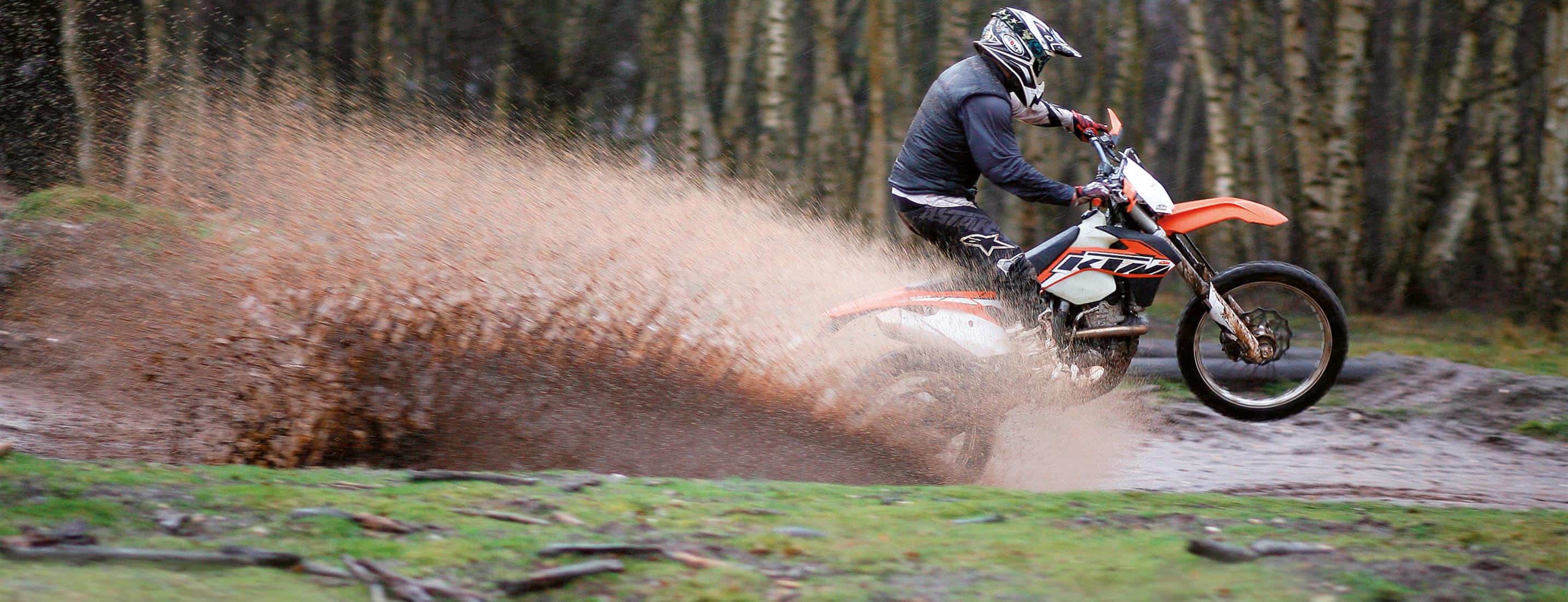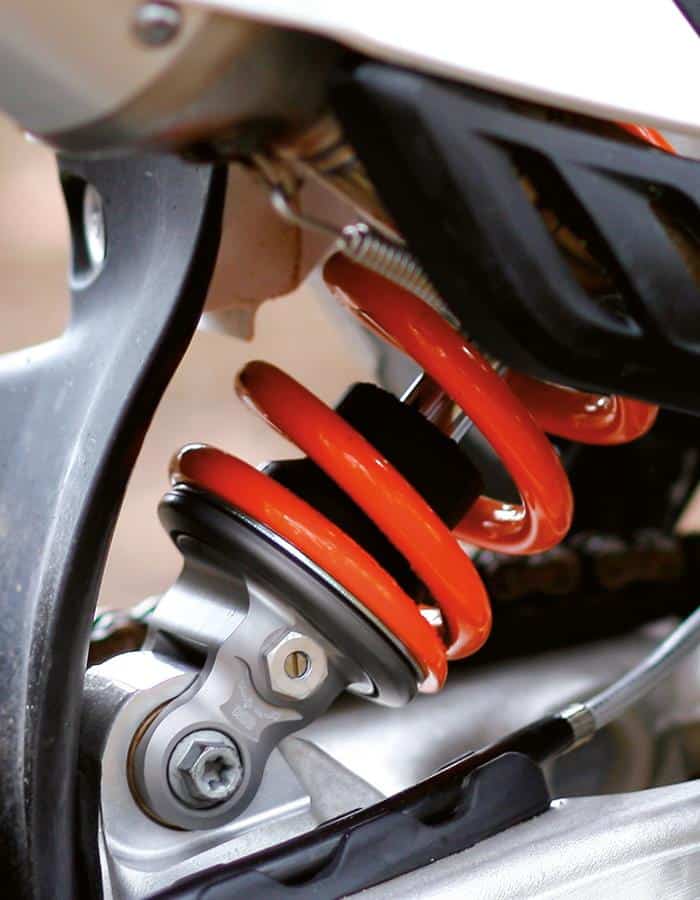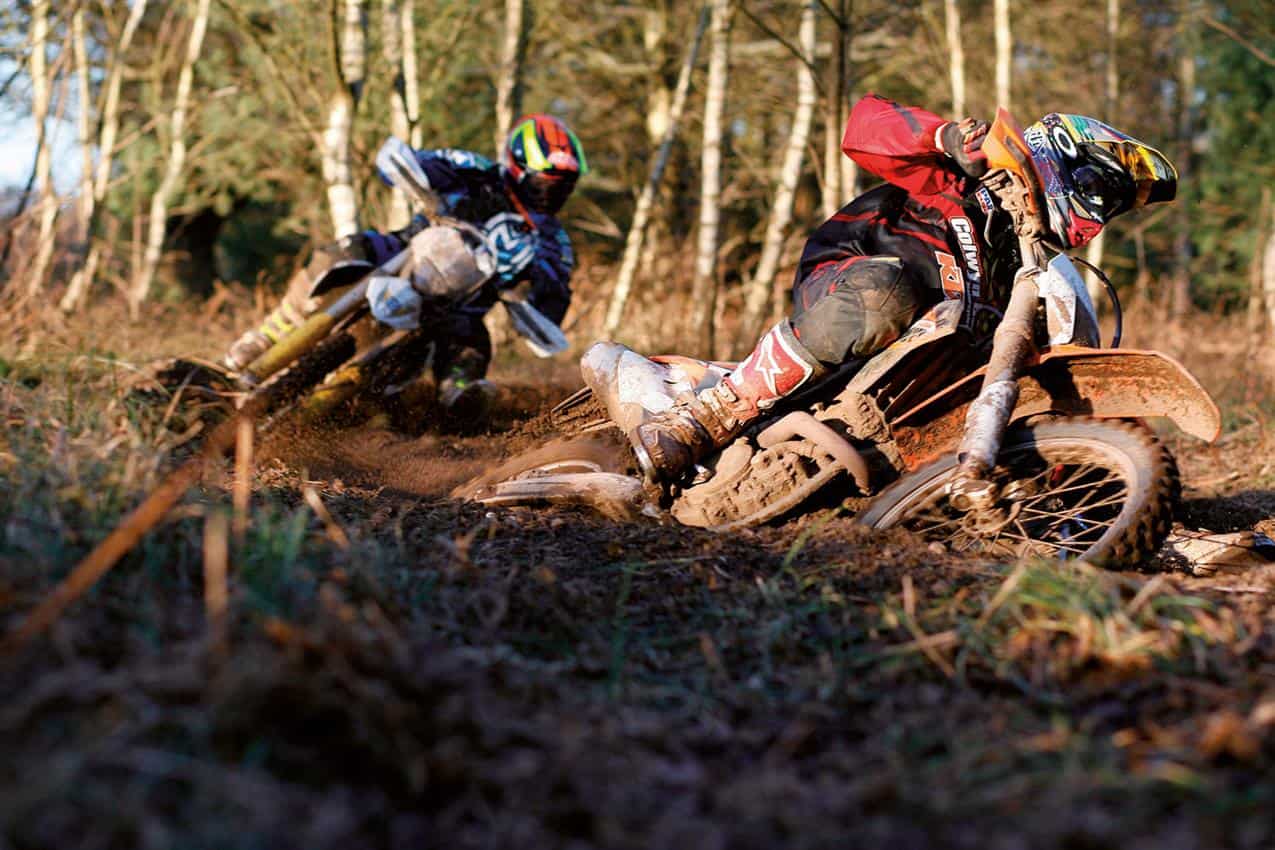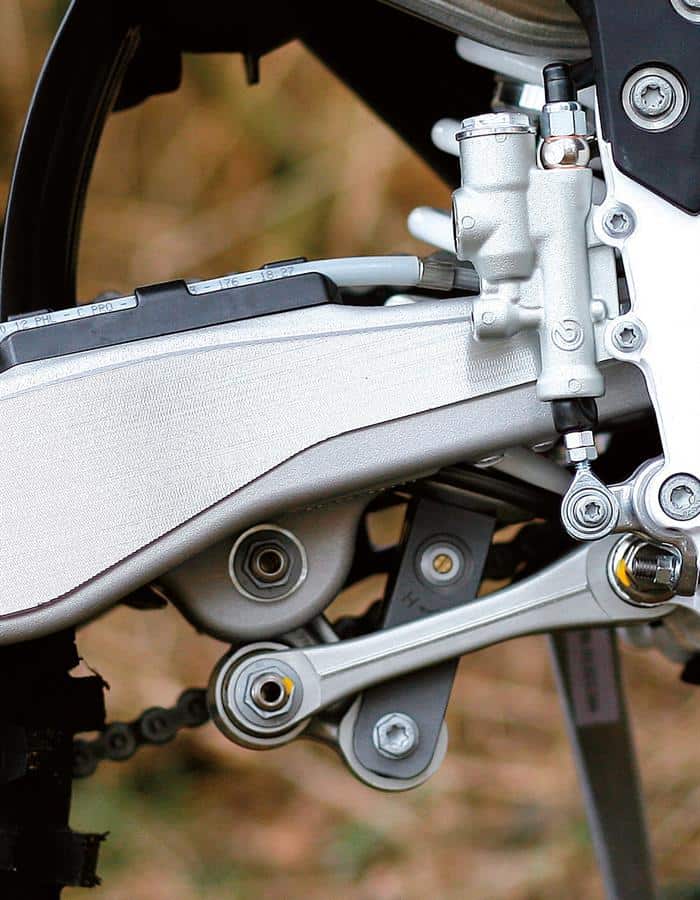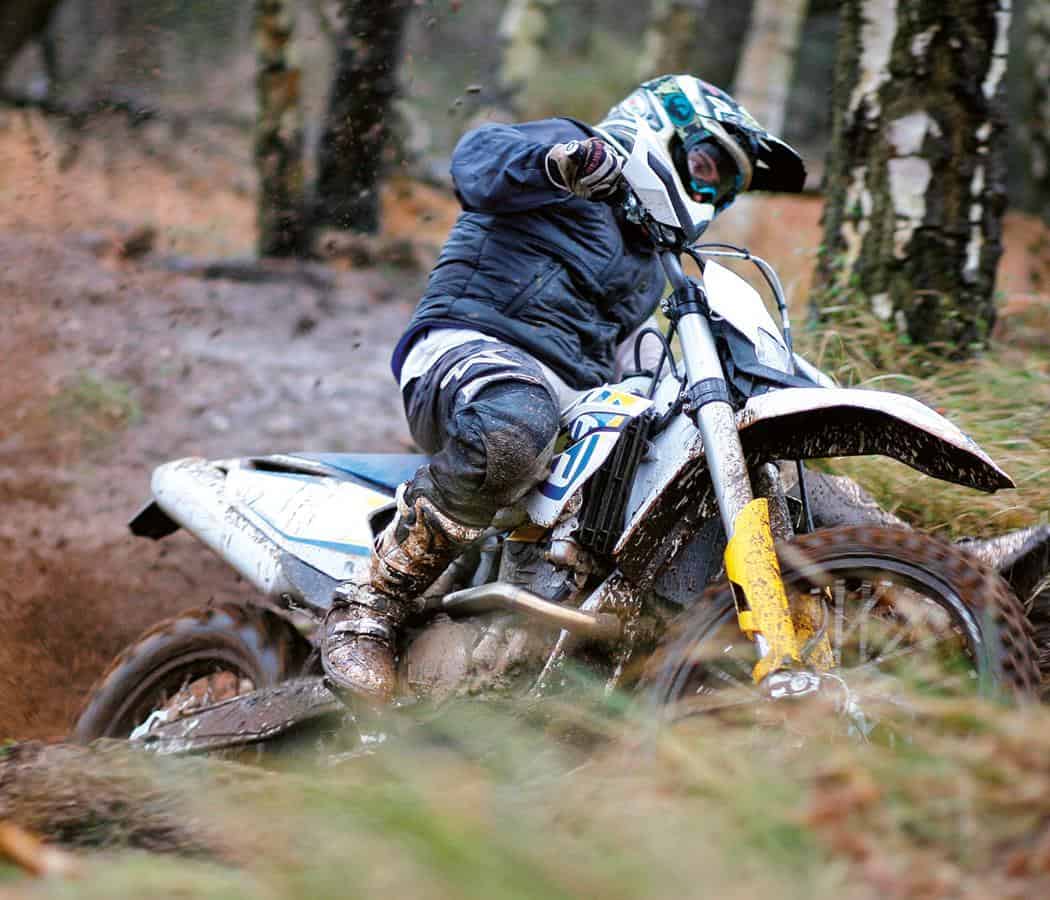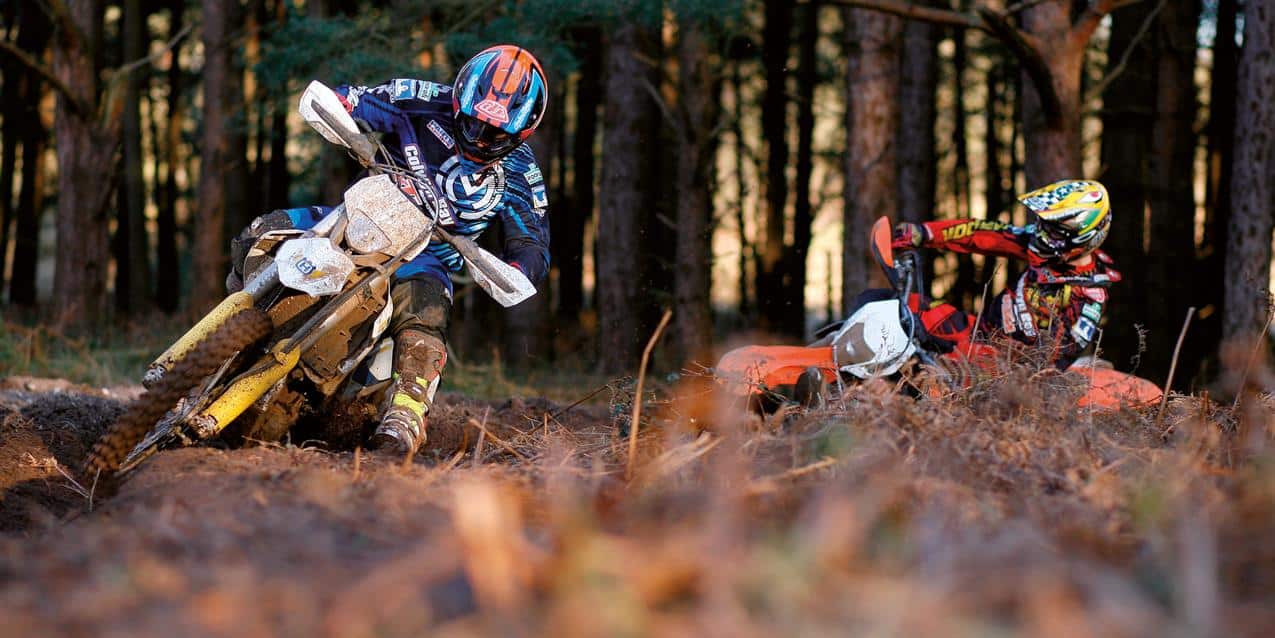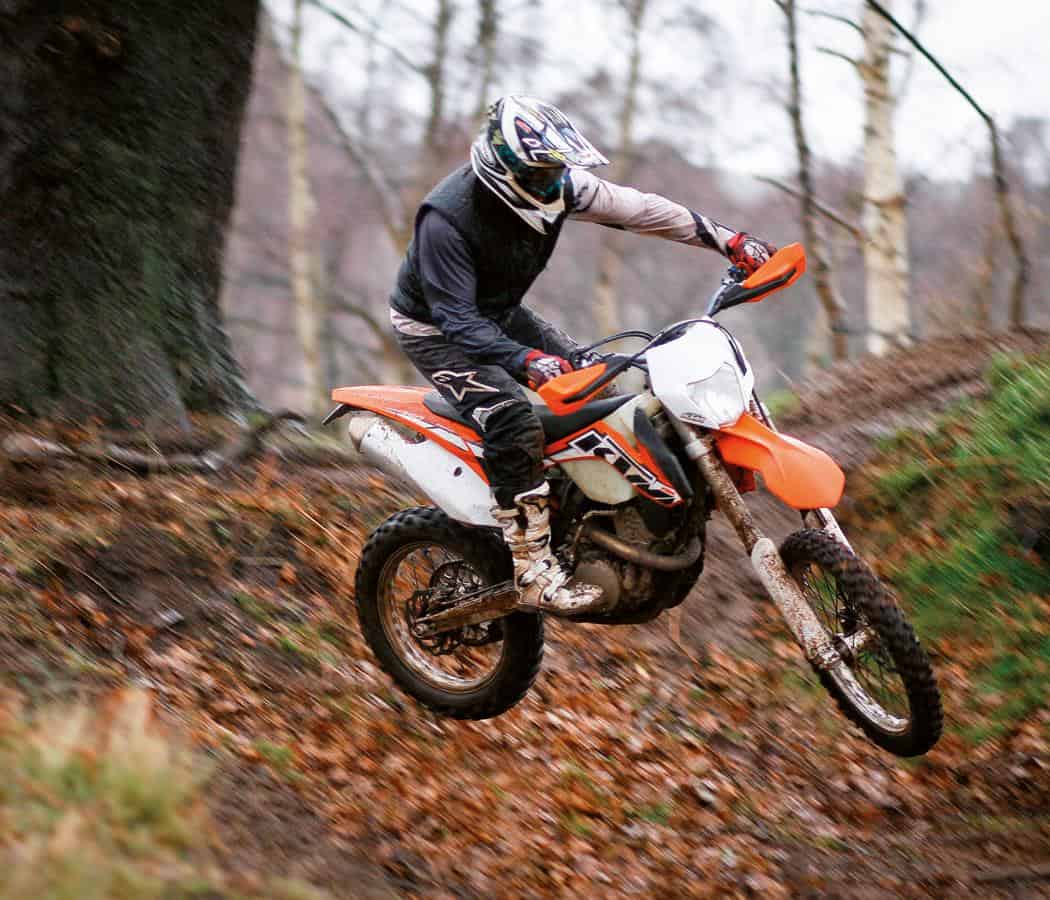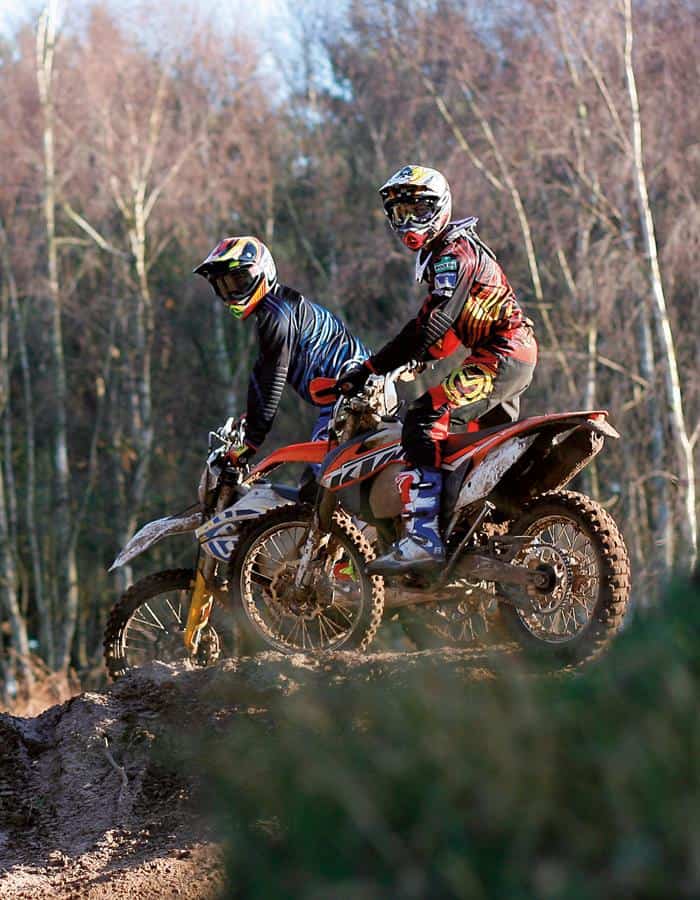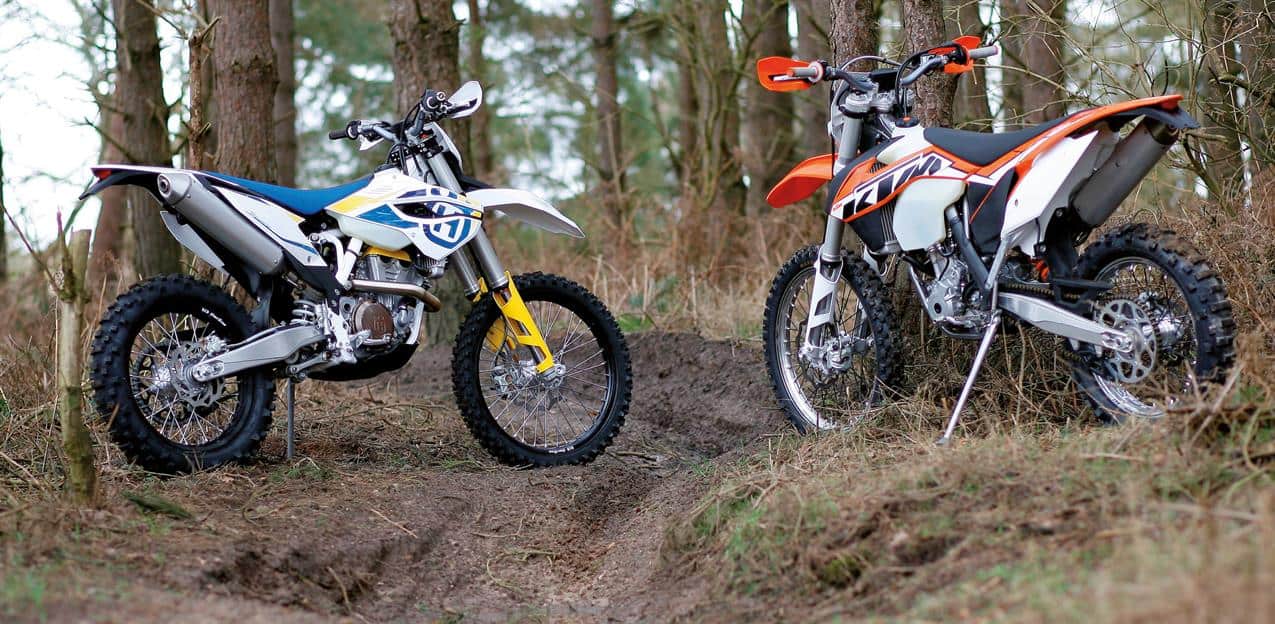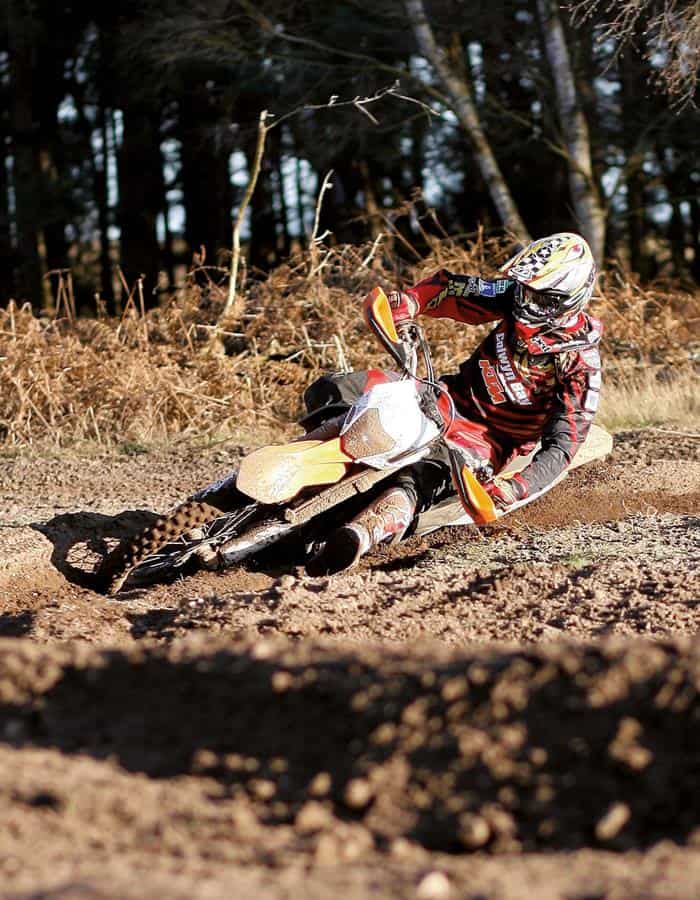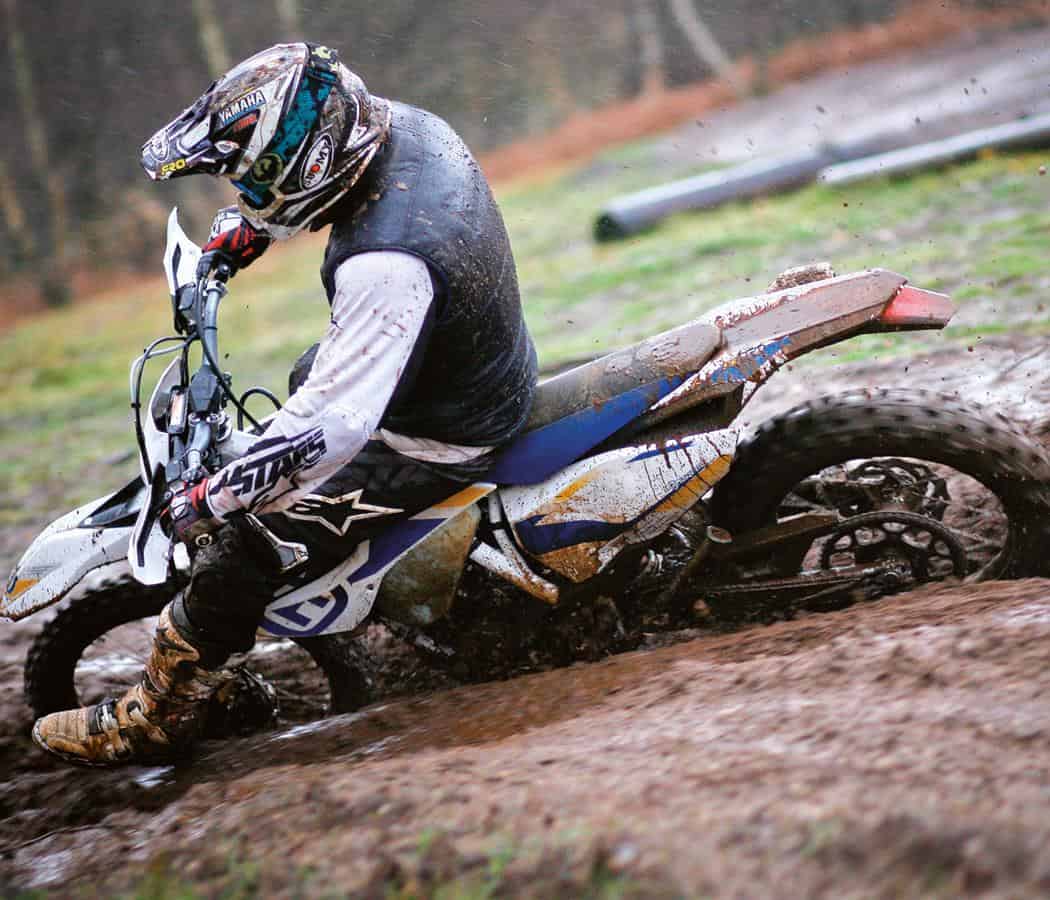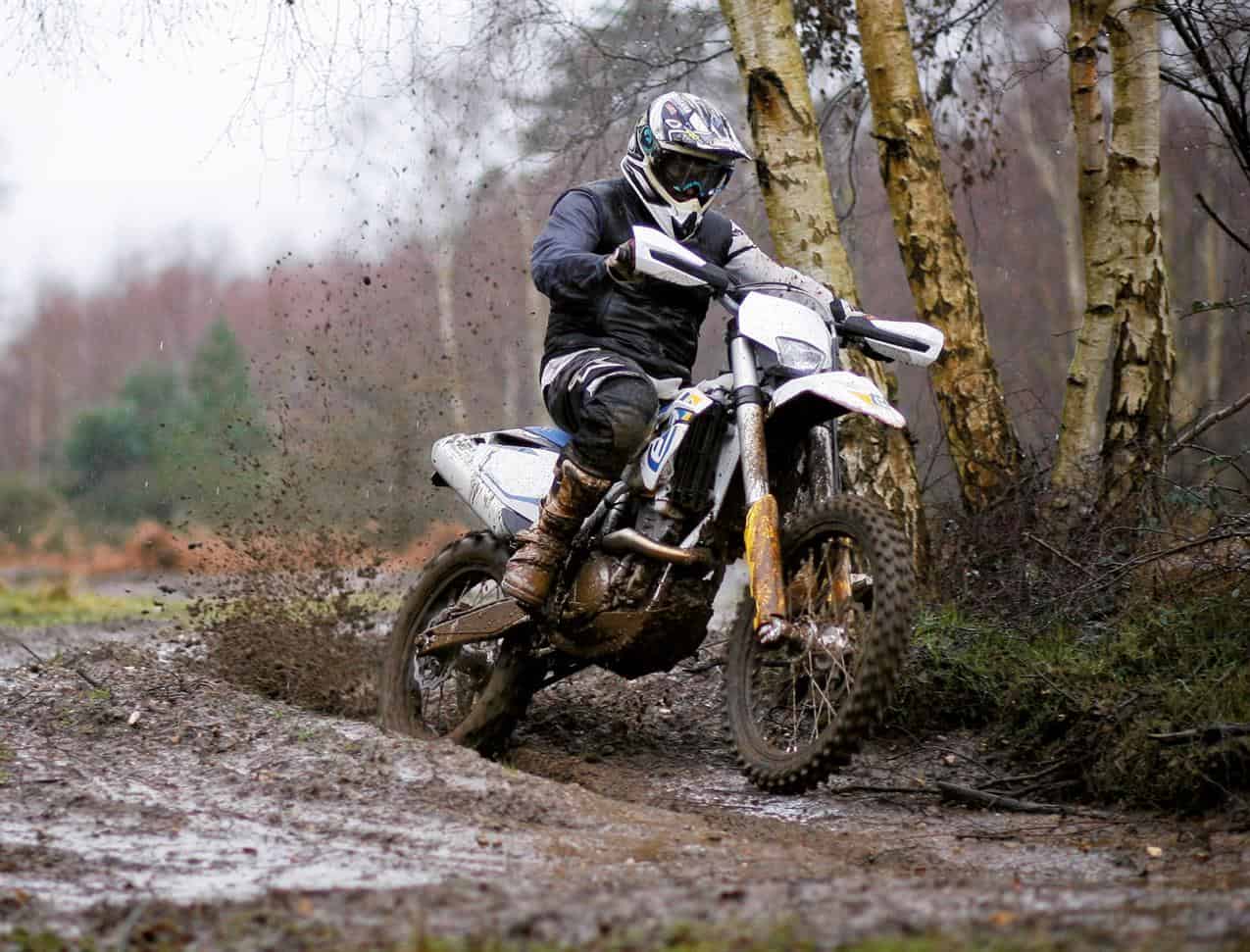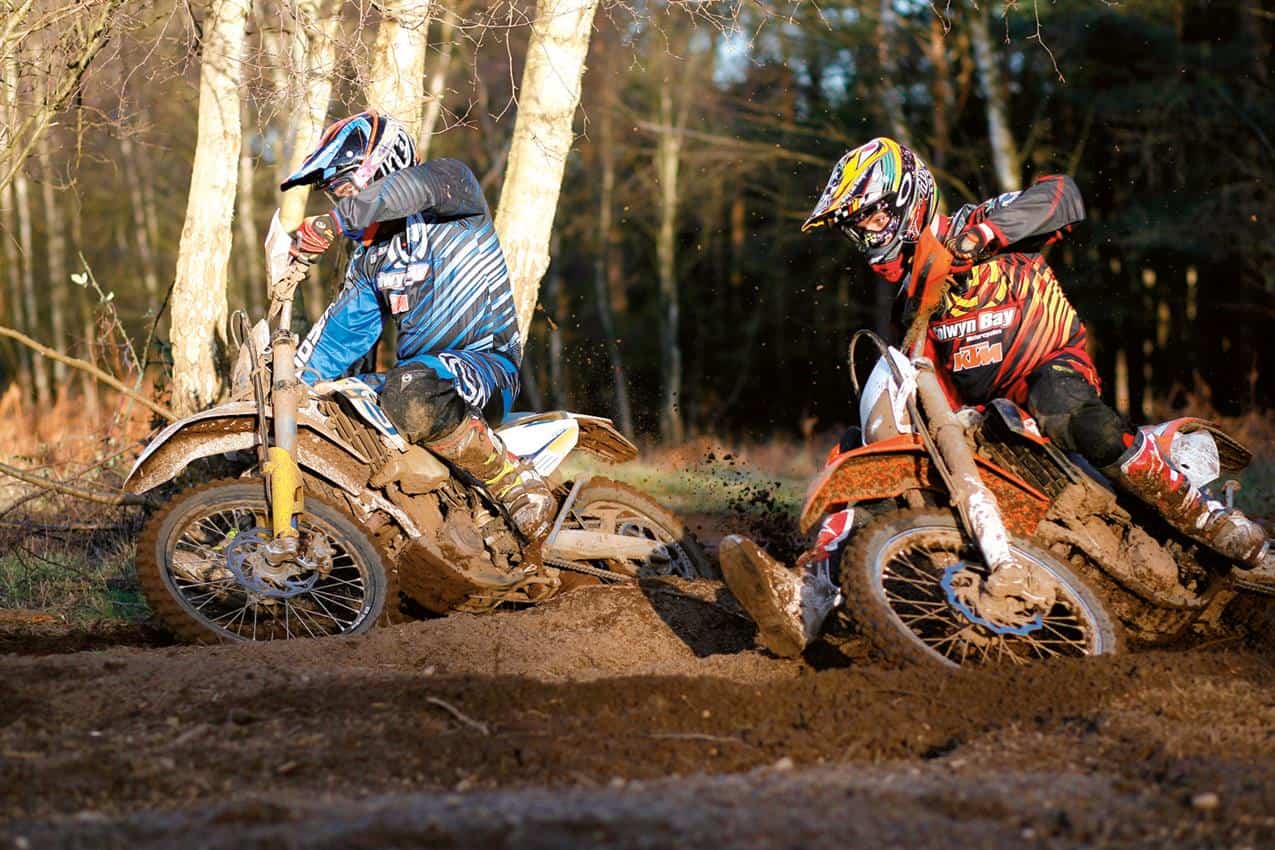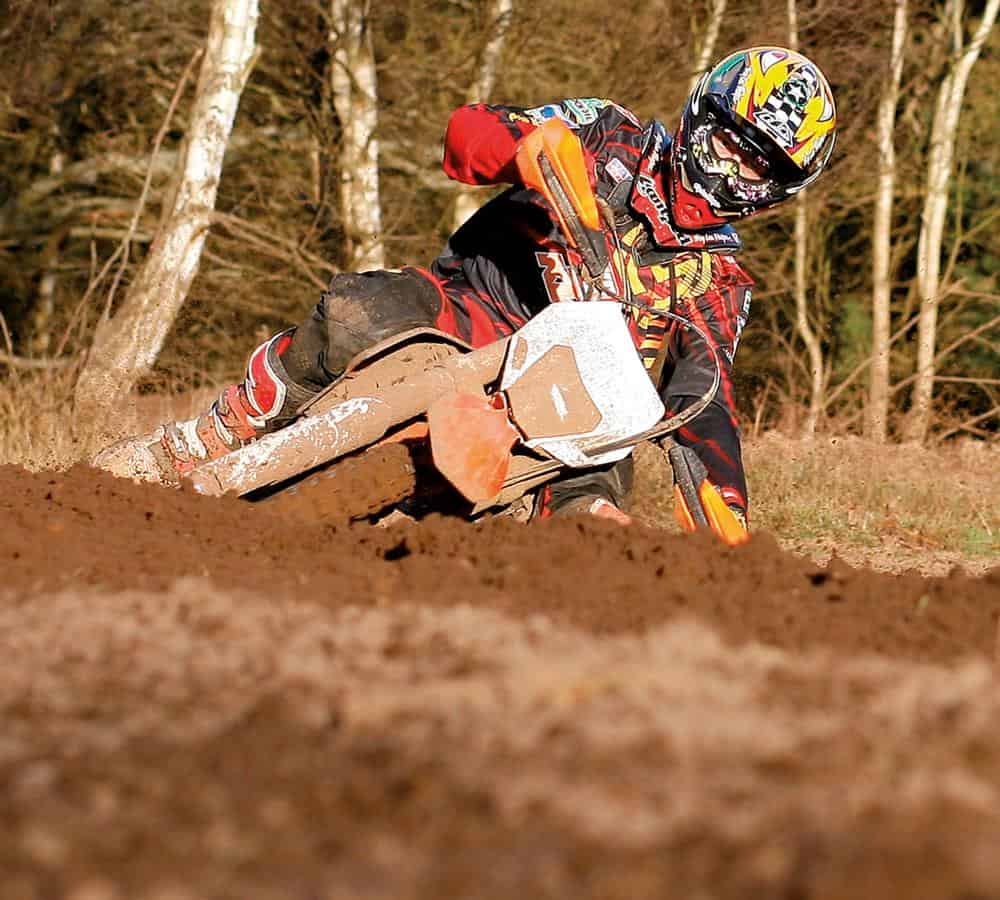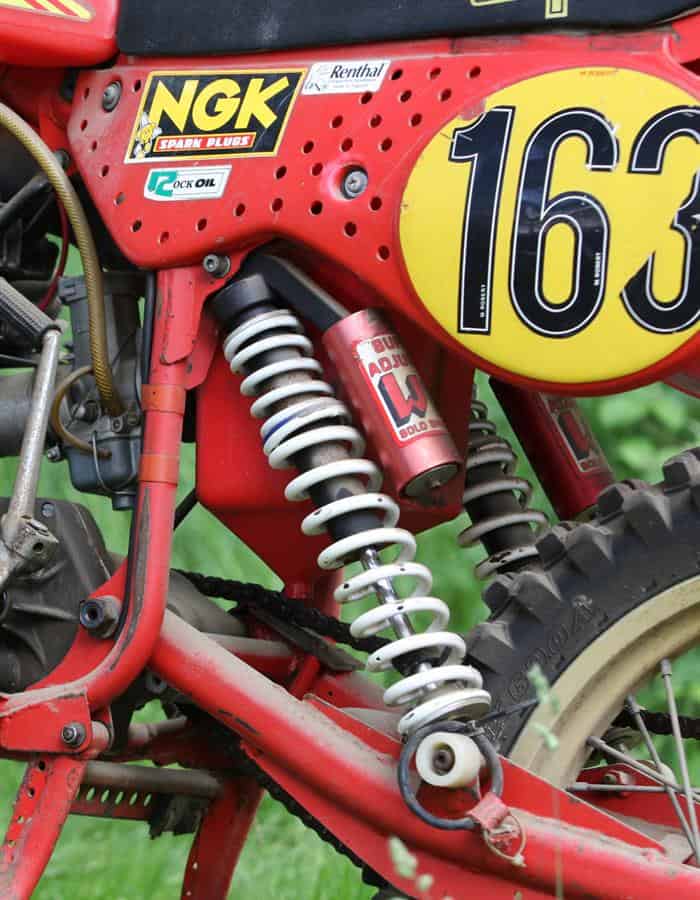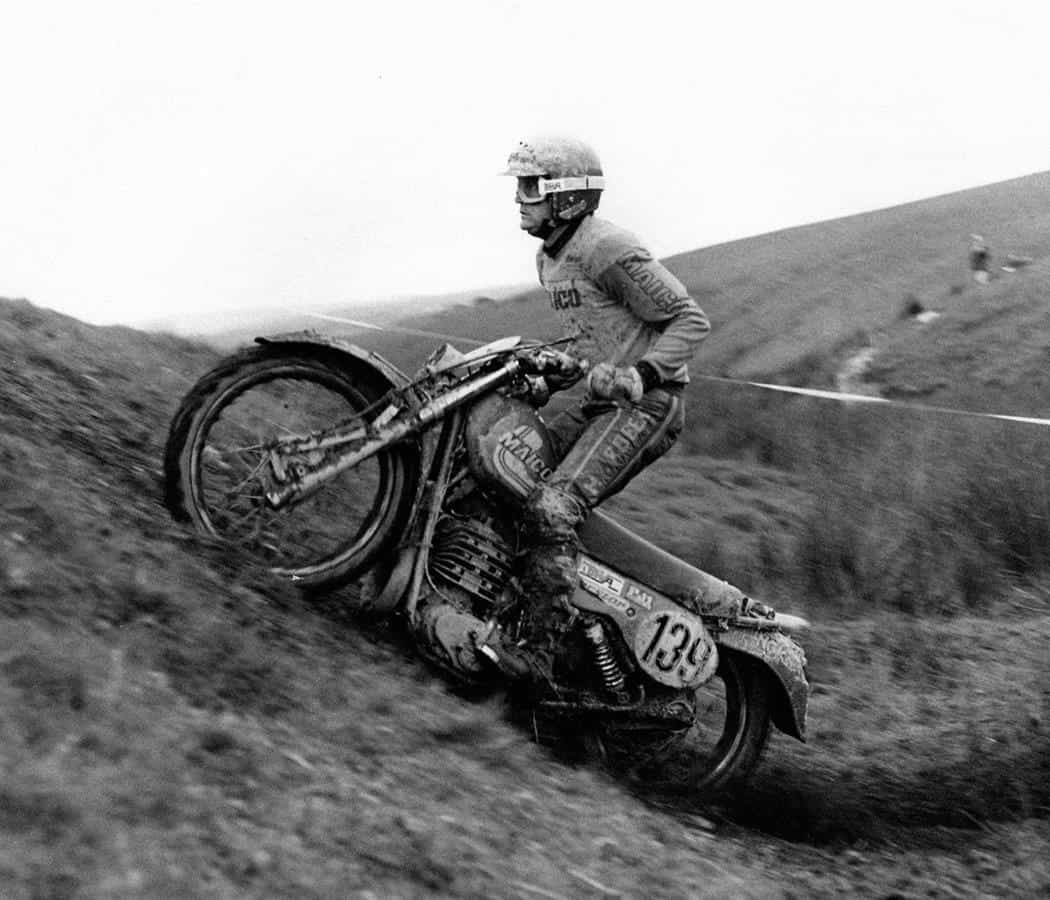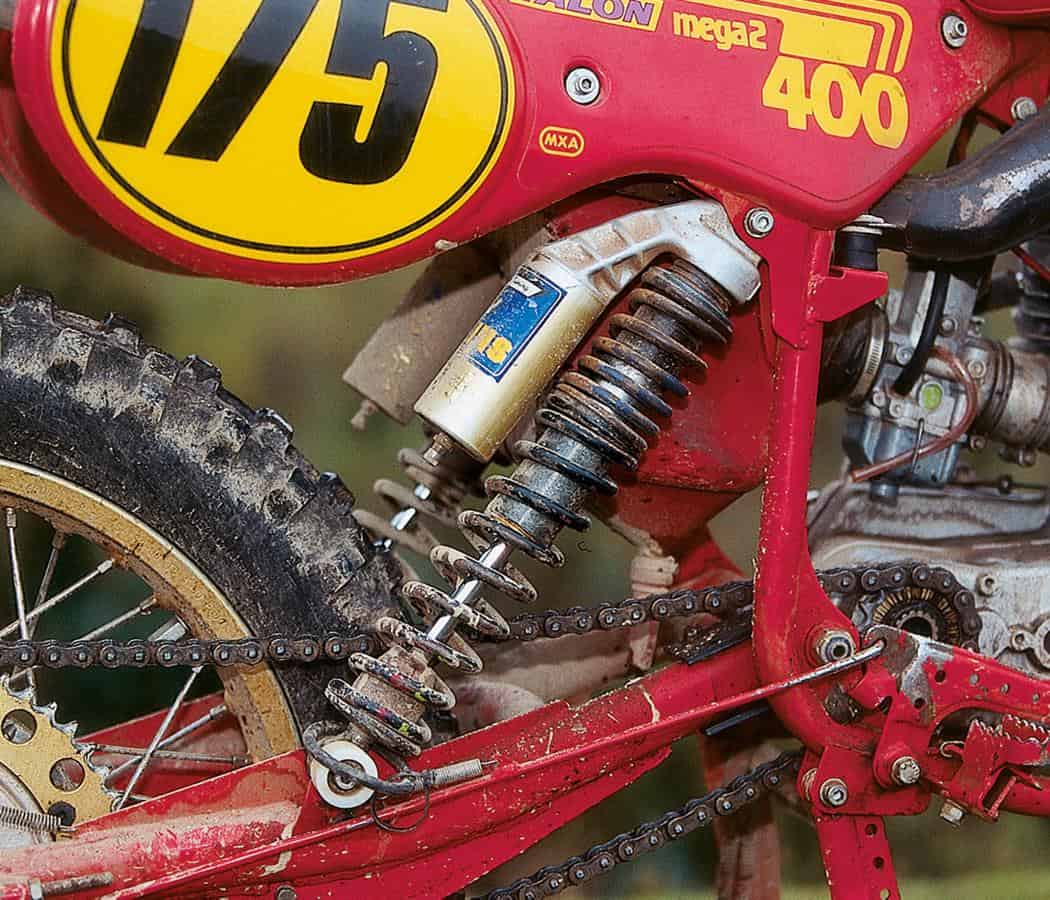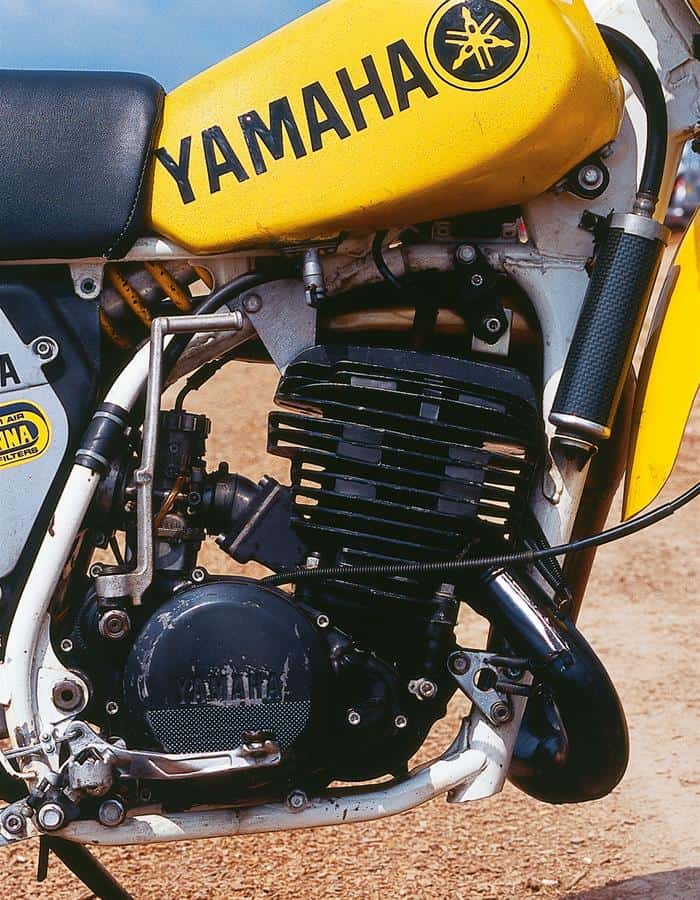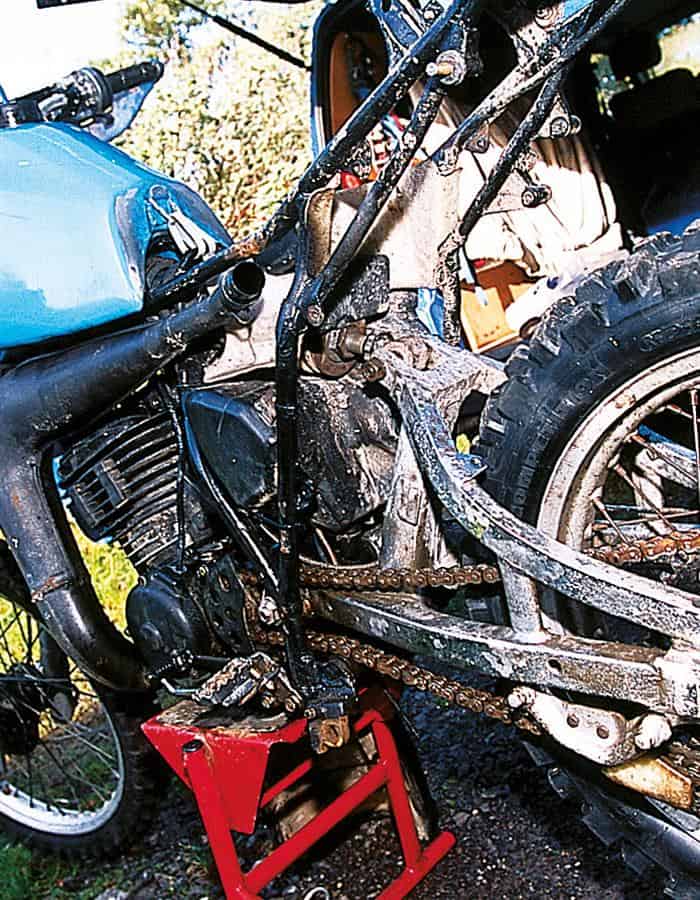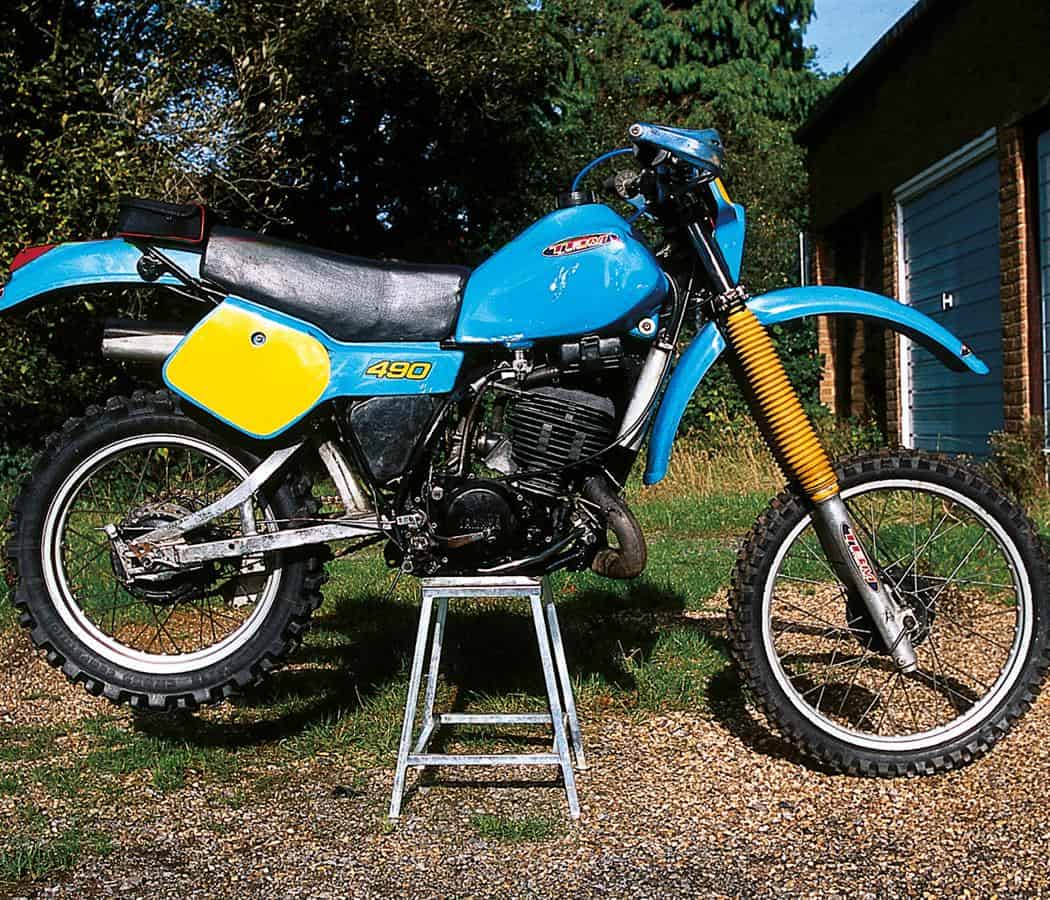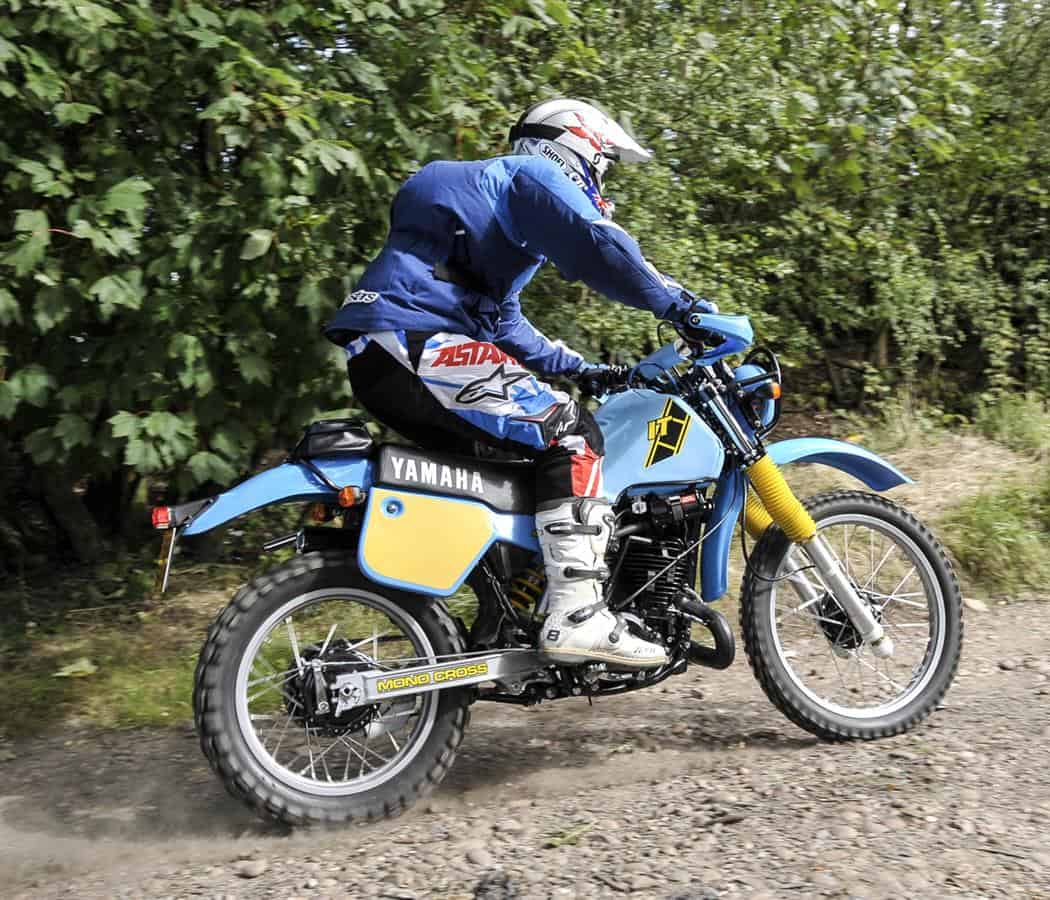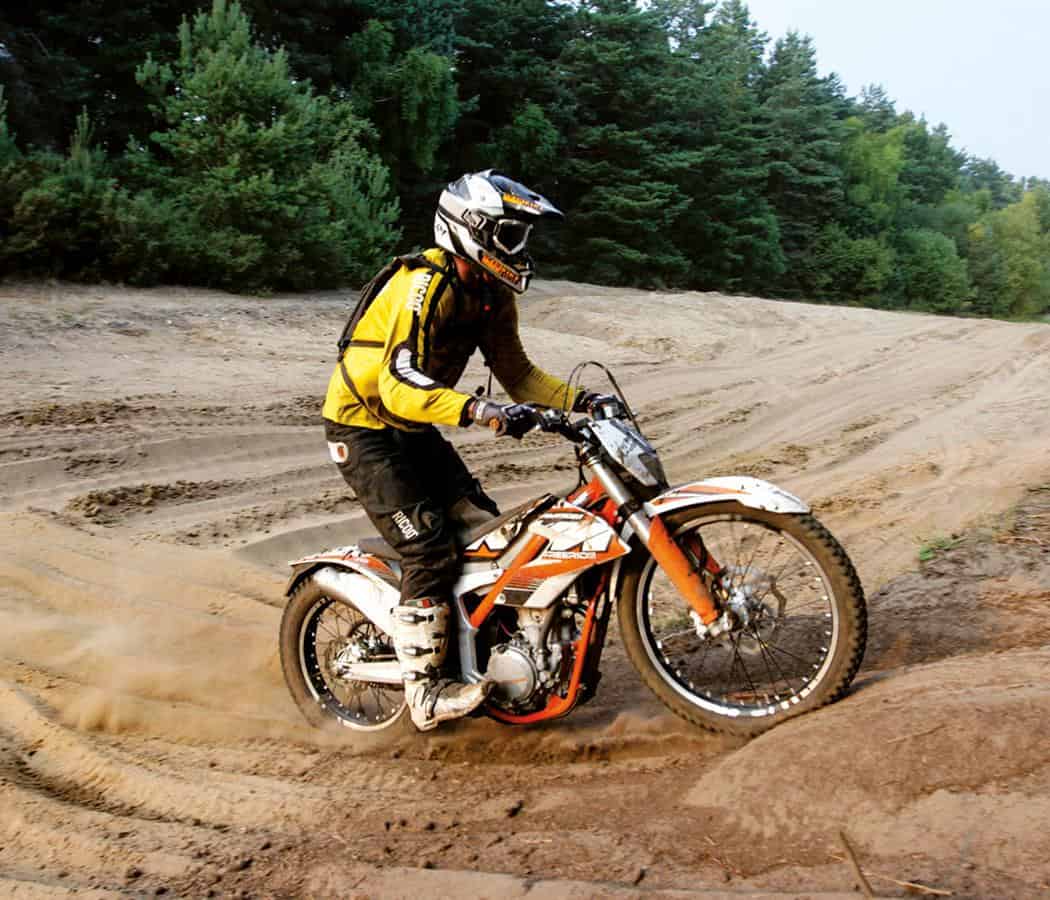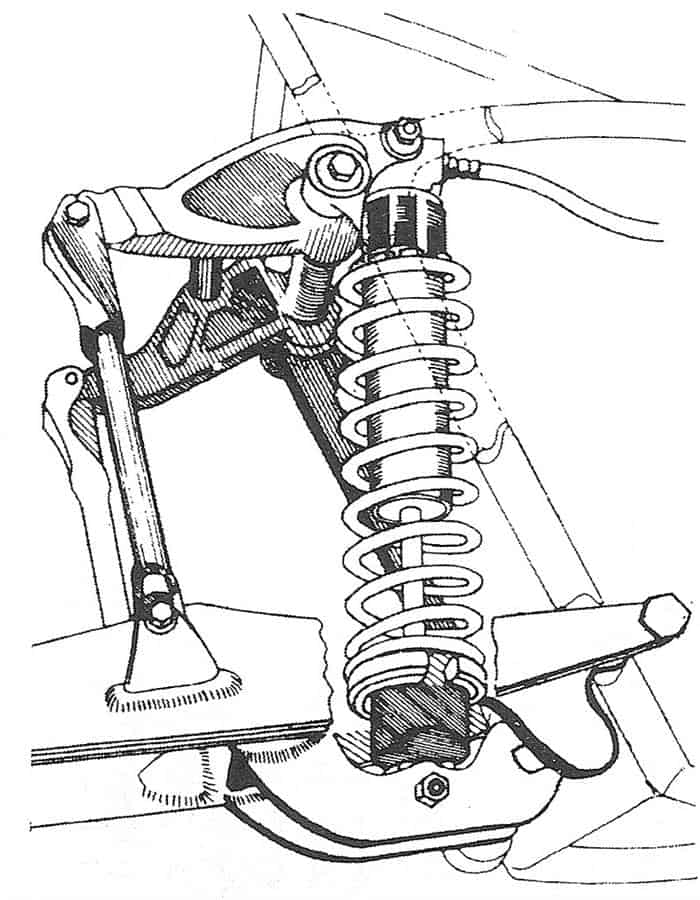Linkage or PDS? That question used to put KTM in a love/hate position in the marketplace – not everyone liked the PDS. Then KTM started putting linkages on their SX and XC models. Now, as of the 2014 model year, we have two KTM-built enduro ranges, one with PDS, and one with linkage rear suspension… the latter being the new Husqvarnas. So now we have a choice. But which is best?
KTMs didn’t always have their link-less Progressive Damping System (PDS) rear suspension. It just seems that way. Prior to 1998 all KTMs came with linkage suspension. But in the mid-to-late 90s KTM set about re-establishing their marque with its own unique brand identity. Part of that overhaul was the adoption of a lightweight, simplified rear suspension set-up that did away with the complicated linkage, and replaced it with a ‘progressive’ shock. It was lighter, simpler, cheaper to produce, easier to maintain and – in the early days at least – not as good as a linkage set-up.
It’s important at this stage to understand the underlying principle behind using a linkage-based rear suspension. At its simplest what the linkage does is to use the principles of varying leverage to add a rising-rate progressiveness to the rate at which the shock is compressed. So that the greater the deflective force on the rear wheel, the greater the force needed to fully compress the rear shock. The corollary of which is that small deflections don’t require much effort to overcome the leverage ratio and thus the shock feels softly sprung for the initial part of the stroke and then progressively firmer for the latter part of the stroke.
The trouble with the PDS system you see, is that it came with certain inherent drawbacks. In a normal linkage the shock extends through a hole in the swingarm down to the linkage below meaning you had quite a long shock absorber. But PDS attached the shock to the top of the swingarm – and that meant using a shorter shock.
That in turn meant the shock internals had less volume to try and achieve the same amount of damping and heat dispersion, and also required a firmer spring to maintain the equivalent performance of a longer (softer) spring. And that combination made for some tricky damping issues.
These were not always easy for KTM to overcome. For instance here’s a quote from a test way back in 2002: ‘The very thing that used to be the selling point of KTMs of old [the suspension] is now one of the main gripes. The action is set up for a very fast fat bloke. Unfortunately I only qualify on one of those counts, and found the sproingers front and back to be uncompromisingly harsh, lacking any real compliance on the plentiful rocks of the tough French course. Towards the end of the two-day race I finally ended up with all the damping adjusters would out to their softest settings. And although the suspension was much improved on its day one performance, the action was still not up to the sort of standard that the Austrian marque’s competition are achieving.’
Damp Start
For a while KTM used a progressively wound spring on the rear shock in order to try and overcome this problem, so as to allow a soft first part of the stroke (for roots etc), and firm end of stroke to absorb the big jumps. But setting damping rates with progressive springs isn’t easy, and in 2004 KTM went back to fitting their shocks with a single-rate spring. And when it came to damping, KTM spent years trying to perfect the system – modifying the damping control each year by way of a two-piston design plus the usual shims. Some years they got better results, some years worse.
PDS has certainly been – excuse the pun – a bumpy road for KTM. It undoubtedly cost them sales in the early days as riders found the PDS rear-end gave a harsher ride than their linkage-equipped Japanese bikes – and often cited it as the main reason for NOT buying orange.
But to be fair, in recent years KTM have finally licked the problem. These days a PDS-equipped bike is easily a match for any linkage-based system. In fact, so good is the latest PDS set-up that many riders now prefer it. I can tell you with all honesty, as a test rider with 15+ years of experience, that whenever I hop on board a modern PDS-equipped bike, I never worry about how the suspension will perform. Because I know it’ll work, and I’ll struggle to tell it apart from a linkage-based system. Nevertheless that is what we are trying to do here… To work out whether the linkage itself offers any significant advantages in terms of suspension, handling and set-up…
‘Bone’ of Contention
When KTM bought Husqvarna from BMW early in 2013, they set a course to develop a whole new range of enduro bikes… In just 21 weeks. Of course they didn’t start from scratch. Hell no. Instead they took the sensible option… sacrificed their existing Husaberg brand by taking the 2013/14 Berg models as the baseline and started working from there. So the new model Husqvarna launch in September didn’t give rise to many shocks (er… excuse the pun again) except in one particular aspect – the linkage (as found on KTM’s SX and XC ranges). The new Huskies are really then a hybrid… or to quote a certain Essex geeza: ‘it’s a KTarnaBerg!’
Actually, you can truly confuse yourself in trying to figure just what part comes from where with the new Huskies. Bergs have in recent years been fitted with the up-specced WP 4CS forks, plus billet clamps. And with those poly-whatsit moulded subframes. But the linkage… hey, that’s already been fitted to KTM’s XC range. Which begs the question, ‘are these XC frames?’
Ahh possibly, but XCs don’t come with 4CS forks… they use KTM’s MX-spec twin cartridge units instead. And the motor in the Husky – that’s not an XC unit either (which has a different gearbox and a fair mix of SX parts for that matter), that’s bog-stock EXC as far as we can tell. The plastic bodywork looks to be pure Husaberg-derived, but of course moulded in a white hue. We were going to say if there’s one thing that’s properly Husky’s own then it’s the new speedo-come-computer unit, only of course that actually debuted on the 2014 Husabergs. Remember them?
So picking out the differences between the EXC and the TE we have: WP 4CS forks and billet clamps, linkage suspension, that resin subframe, an extra half-litre of fuel capacity, the speedo thingy, black rims and alloy spokes (alloy rims and black spokes on the EXC), Berg plastics and Husky paint and graphics. Oh yes, and the Husky follows the Berg practice of dispensing with the kick start. You’d think that that last bit would make the Husky lighter, but according to the specs it isn’t… In fact it’s two kilos heavier at 109.2kg without fuel. Perhaps that’s the weight of the linkage?
And from that list you’d say the most significant difference is the suspension – the Husky has the dog bones (you know, part of the linkage), and the 4CS forks. Any suspension tuner will tell you, you have to consider the suspension units together; how each works has an effect on how the other works too. Get one wrong and it’ll send the balance out and make the other feel wrong too. It’s ultimately the suspension that defines the new Husqvarnas. And it’s where this test begins…
The Test. Part One: Doggy Paddle
Unexpectedly it’s taken us a long time to get a like-for-like KTM and Husky together for a back-to-back test. You can blame us for being slack, but we blame the KTMs for being so popular and for selling out every time a batch of bikes arrives! The late arrival of the Huskies didn’t help. Neither did the Christmas break. Nor the weather. But finally come Feb we had a pair of 350s, an EXC and a TE. The EXC had a fair few hours on its motor, the TE however was brand spanking new.
Next job was finding somewhere to ride. For eight straight weeks this country has been wearing Speedos and a snorkel. Even if you did find someone prepared to let you roll knobbly over their turf you wouldn’t recognise either machine within five minutes of setting off. So of course, we had but one option… Not Spain… Suffolk. On an all-weather Sandy enduro track we finally managed to get out and go testing. And even that on the first attempt was seriously wet.
We had that fellow Chris ‘Kiwi’ Hockey along again – it’s his track! – and man we got so wet and so cold that he crashed three times just because he couldn’t hold on to the bars any longer. So it took us two attempts to get the testing done. Part one was wet and horrible, and part two was in pleasant sunshine (though still cold), so at least we had all bases covered. Then we broke it down even further into two opinions: one being the clubman view, and the second is the view of the expert rider. You can’t say we’re not thorough…
Clubman Capers: The Lazy Labrador
Starting with the KTM (and the clubman). KTM have made their models so natural, so instinctive to ride, that you just jump on and go. About the only adjustment needed is to set the bars to your personal preference of forward or back – although a few still say they’d change them to a bend that arguably feels more upright.
The bike starts on the button, warms quickly and simply gets on with the job. The handling is precise, the suspension plush. The power is pretty clubman friendly. Third gear is a do-it all gear given a little clutch slip in tighter corners, and you simply ride the gentle torque of the lower half of the rev range. For racing that’s no way to set fast times, but for long hours on the trail it’s spot on.
The tracks we were testing on were an unholy mess of whoops, with deep puddles, laced with wet polished roots, and here and there were boggy bits with nasty ruts. The KTM just danced around them, the feeling is accurate and confidence inspiring. The glitches – do you recall the starter issues, the stuttering fuel injection, the harsh mid-stroke on WP forks – all seem consigned to the history books. This is fault-free dirt biking.
The KTM simply loves to make smooth flowing progress and despite the torrential rain and the odd slip, it allowed a neat precise ride. We had a riding companion along with a 350XC and in the same conditions he was fighting with his ride. The XC motor is that bit more SX in its power delivery, the suspension that bit more firm, and consequently he was struggling to find a consistent smooth state. He jumped on the EXC and was won over. One minute he was beaten up, the next he was suggesting he could go eight hours, comfortably!
Hopping on the Husqvarna it was obvious this bike was brand new, fresh out of the crate. The motor felt to have a bit more edge to it, kicking in just that instant quicker and with a bit more punch. If the EXC had been a clubman’s friend, this felt to be the ride for the keener, wanna-win clubman. The extra punch was welcome in fact – it kind of showed why you should renew your piston and rings in a four-stroke every so often, and keep on top of the top-end maintenance. A crispy motor is a very fine thing.
The Husky felt different too, for no better reason than it was a different bike. Not like a different model, but another example, like when you jump on a mate’s exact same model only he’s changed the bars, got the sag set differently and such. For a while you’d want to be back on the KTM, back with our comfortable slippers. Only when you got back on the KTM you missed the fresh feel of the Husky.
As far as the handling goes it would be so easy for this clubman-level rider to come up with a list of differences, nuances. For a while I was willing to believe them myself. In the tight woods I was thinking the KTM was the winner, and then when I was riding the whoops and faster sandy sections I was thinking the Husky was stroking it with the plush feel of the linkage. But honestly – I think in my heart I knew I would crumble under cross-examination. It was too close. I couldn’t even get one answer in my mind as to which I preferred aesthetically, let alone dynamically. I liked them both. I t was like trying to pick a favourite among your own kids.
It’s worth adding that this is all in the nature of testing – the feedback very much depends on where you are riding. A mid-summer ride would I’m sure, reveal different opinions. For instance a couple of seasons ago I tested a Gas Gas EC300 back to back with a KTM 300EXC and the link/no-link question then was clear cut. I loved the KTM, but I loved the Gasser more, mostly for the flat out test-type riding – it was on the brakes skipping over the braking bumps you could feel the difference, the KTM being just that bit more flighty at the rear where the Gasser tracked into a corner straight as an arrow. At the launch of the new Huskies in Sweden I also felt an affinity with the linkage set-up, it felt like it rode that little bit lower, that little more evenly over the bumps. But on this occasion, in the wettest winter ever, I’d be lying if I said I could tell.
One thing was for certain, I was loving the 350 vibe again. There’s a reason the 350s have been stealing sales from the 250/300cc two-strokes – they’re just that much easier to ride. One factor is the 350 makes around five to eight horsepower less than a 300 two-stroke. It’s surprising how much more manageable that makes the 350. Add a few extra kilos weight as well and it becomes altogether less frisky when padding down the trails, it tends to stay planted. There’s control and enough power. For a young buck the excitement and ultimate performance hit of a 250 or 300cc two-stroke will probably still win the day, but for us older units (and my knees are agreeing with me on this) the 350 four-stroke sure does make good trail speed easy.
Expert Opinions: A Speedy Greyhound
‘I can, I can, I can!’ Yes indeed, Kiwi can feel the difference between the PDS bike and the linkage bike. He’s got a more sensitive feel, and being a suspension specialist and a championship-level racer, this kind of evaluation is second nature to him. If you were a championship level racer these would be the kind of comments you might be making…
‘The KTM with the PDS always feels different to any other bike, but you do get used to it and it does have its advantages. But I always want to lower the back end with a PDS bike, mostly because of my experience of Japanese bikes and because I ride in sand and because I’ve got short legs. I like a bike which is low at the back… that’s my set-up.
‘I remember when I used to go to the KTM launches, after a lap I’d come in and tell the guys to drop the back end and they’d say ‘you must get used to the bike’. I’d stick with it and in time I’d appreciate how good they were at turning, especially on rocks and in slippery awkward tight trees – the KTM turns immensely well, even on flat surfaces.
‘But we haven’t got those conditions here, even our extreme test is full of berms, there’s grip everywhere and so lowering the back end here works. And so to me the Husky feels more like a Japanese bike, only with the KTM engine. I’m quite impressed. The Husky is more like a KTM that is set up for me.
‘It’s not perfect though. On the first ride, when it was wet here and I was wasn’t pushing on, it felt quite firm – as the bushes and seals were still new making it feel firmer. Now they’ve all bedded in and in the slightly drier conditions I’m riding faster, and I am bottoming it out in quite a few places. And the track still isn’t as fast as it can be in summer. Actually I’ve cased a hole on more than one occasion and it’s hooked into the ground and launched me forward. I’ve never had that with a Japanese bike, it’s almost like they’ve taken the PDS frame and put the linkage on it – and so the linkage sits too low, if you bottom out and there’s a rock or a root there it does dig in. For extreme enduro purposes that might be a bit of a problem for a few people, but generally riders won’t notice it.
‘I’m not completely convinced about the front end either! The idea of the billet clamps is spot on: they bring strength, they hold the fork better, they’re not just a fancy colour, they do make it a lot more positive and if you were racing it hard, in dry conditions, you might feel a bit more positive with the billet clamps. But here, in these conditions, I’ve hardly noticed the difference!
‘And I’m not so sure the 4CS forks are the perfect call for enduro. I prefer the action of the single chamber fork on the KTM to the 4CS, on every bike I’ve ridden. In my opinion the 4CS fork particularly didn’t work so well with the PDS, it could make the shock feel really hard. But now the 4CS paired with the linkage… it does at least feel like a well balanced bike.
‘I have an issue with the gearbox as well; the gap between second and third feels too big. In second you can be spinning too quickly then swap up to third and it’ll bog the motor, too much.’
Other Stuff
This gearbox issue is the same for both the Husky and the KTM, as they share the same motor. Checking out the spec sheet you can spot the issue. While second gear is identical to that in the KTM 350SX-F, that enduro third gear is a whole bunch taller than found on the crosser. Actually looking through the EXC range, third gear is consistently a bigger jump than a motocross bike would make. Now that works, as I said, for riding trails at a nice steady pace, but when it comes to needing to accelerate hard in a test, it can cost you a second or two.
Of course you can lower the gearing – fitting a larger rear sprocket would do the trick – but the gain of bring third into range, comes at the cost of consigning second into the ‘too low for anything’ basket! On the other hand, you must remember that these are the opinions of a top level rider. But in the real world of the clubman rider, having to make choices between off-the-shelf bikes for us to ride casually of a weekend there’s no grounds for complaint. Kiwi continues:
‘Yeah, for the average rider the Husky is an incredibly good bike. Chassis wise, handling wise, balance wise, power, grunt, torque – it’s all spot on. Good as I’ve ever had with a bike out of the box really. Most of the time you have a list as long as your arm of things you’d like to change, but not here. And I love the details: the lovely big tank, and it’s see-through! For a three hour race it would be mega. It doesn’t feel big and it doesn’t make the bike feel like it’s stood on its nose. If you get an oversize tank on a motocrosser suddenly it feels like you’ve got a jerry can strapped to your front mudguard, but the Husky isn’t like that. The tank sits nicely down the side of the bike, that’s one well designed tank there!’
Choice Words
For Kiwi the choice is a foregone conclusion: ‘In these conditions, you need more of a motocross linkage type set up. With bump after bump after bump, preloading the suspension, hitting a bump to jump off and carry over two bumps – for that the PDS isn’t quite as good as a linkage. But in Wales, on slippery grass tests, on flat turns with roots and rocks, it’s PDS any day of the week.’
But on balance, for Kiwi – you could see by the shine in his eyes, by the way he always dangled his goggles and helmet off the Husky’s handlebars when we stopped (never the KTM’s), the new white, blue and yellow machine wins his vote every time. Like he said, it’s a KTM that’s set up for him.
For me, the clubman level rider, the decision is less clear cut. I wasn’t alone in being unable to detect a clear advantage with the linkage – and much of the time I was struggling to feel any difference at all.
Is the Husky the more handsome looking bike? I’m not sure and in any case when you’re riding all you see is the front mudguard. And do looks really count? Okay the Husky’s new speedo sure does look swell – but hey, when have I ever looked at that on the trail, except when stopped? And of course while Kiwi explains quite logically that the linkage works best in the conditions we rode, I can’t explain why it was more often than not that I was wearing the biggest grin after riding the KTM. It doesn’t just cope in such conditions… it shines.
Does having a kickstart (on the KTM) sway my thinking? A few years ago, when test bikes would regularly not start on the button if left for a week without use – yes. But these last couple of years electric start has been pretty faultless (Freeride excepted).
Will I buy a KTM because Antoine Meo races one? No. Enduro demi-gods can win on anything half decent. I think there are other factors that will affect your choice. Dealer coverage is probably one of incredible bearing. A solid local dealer is worth his weight in gold. Yep, it might come down to what’s on offer closest to you.
And price matters, of course. To that effect you have to look at how the bods in Mattighofen are positioning these two bikes. They call the Husky their premium product. The base price on the TE is £300 higher than the EXC, and the availability is a significantly more restricted. The KTM is produced in greater numbers and right now there’s an effective £500 discount being applied by way of buyer incentives. That makes the Husky today a good £800 more expensive than the KTM. How does that sway the thinking? I suspect way more than the argument of linkage or PDS.
As it goes, in Suffolk we have reached a state of harmony: Kiwi’s loving the new Husky, I’m just as happy on the KTM. Perhaps it’s just a speed thing after all…
KTM 350EXC
Price: £7249 (In 2014)
Engine: Liquid-cooled DOHC single cylinder four-stroke
Displacement: 349.7cc
Bore & stroke: 88 x 57.5mm
Carburetion: Fuel injected
Gearbox: Six speed, hydraulically actuated DDS clutch
Starting: electric and kick
Frame: Chro-mo central tube frame, alloy sub frame
Front susp: WP USD 4860 MXMA PA forks
Rear susp: WP PDS 5018DCC shock
Front brake: 260mm disc, twin piston Brembo caliper
Wheelbase: 1482 +/–10mm
Seat height: 970mm
Ground clearance: 345mm
Fuel capacity: 9 litres
Weight: 107.2kg without fuel
Contact: 01280 709500
Husqvarna TE350
Price: £7549 (In 2014)
Engine: Liquid-cooled DOHC single cylinder four-stroke
Displacement: 349.7cc
Bore & stroke: 88 x 57.5mm
Carburetion: Fuel injected
Gearbox: Six speed, hydraulically actuated DDS clutch
Starting: Electric only
Frame: Chro-mo central tube frame, sub frame
Front susp: WP USD 4CS forks
Rear susp: WP monoshock with linkage
Front brake: 260mm disc, twin piston Brembo caliper
Wheelbase: 1482 +/–10mm
Seat height: 970mm
Ground clearance: 345mm
Fuel capacity: 9.5 litres
Weight: 109.2kg without fuel
Contact: 01280 709500
The Missing Link
Words: Jon Bentman/Si Melber Pics: Jon Bentman, KTM, ….
A short, potted history of dirtbike rear suspension…
Suspension has always been – probably always will be – a tricky matter. Especially when it comes to dirt bikes. That’s on account of all the variables. There are so many of them it makes the mind boggle. Just considering the bike alone, the moment you adjust the positioning of a hypothetical suspension unit from an upright position (directly above the rear axle) to an inclined position you add a degree of progressivity to the rate at which it takes up forces.
Then move that unit up the swingarm and again the calculations become even more intricate as now you can add leverage ratios to the progression ratios. Then add spring rates, valving, internal pressurization, a rising rate linkage, add the effect of thottle-on or throttle-off, and the inclination of the machine at the time and you can see how complex it becomes.
Then you get the variables relating to the rider. Fast riders, slow riders, heavy riders, light riders, riders who ride seated, those who ride standing, ones who lean forward or who stand upright, ones who use lots of throttle, who ride everywhere in third gear, or who race up and down the gearbox in a frenzy…
And then there’s the variables relating to terrain and conditions: sand, loam, clay, rock, roots, wet, dry, hills, flat, sun, snow, even altitude will have an effect.
You might for one set of circumstances on one day achieve the ideal set-up, only for one factor to change slightly the next day, and so again you’re looking for a whole new configuration. It’s why the pros set their bike up at every race they attend.
Even just in the UK the difference in terrain between east and west, north and south can be huge. Now imagine the differences between riding in Iceland or South Africa, between Chile or indeed Chippenham. How do you make one set of suspension cope with everything? You can see this is one very technical area of motorcycle technology…
Of course there was a time when a simple sprung saddle was considered the height of rear suspension technology. You could argue that Enfield India still do… And although motorcycles have had rudimentary suspension systems from at least as early as 1905, it wasn’t until the post war period of the early Fifties when virtually all motorcycle manufacturers began fitting twin shock absorbers attached to a swinging arm that the meteoric rise in the sport of scrambling could really begin.
Throughout the Fifties and Sixties, and even into the early Seventies a simple twin-shock setup formed the basis of the off-road machine’s rear suspension during which time suspension travel slowly crept up from 2.5in to approximately 7in. But by then it was becoming clear that additional travel (and ground clearance) could allow motorcycles to travel even faster over rough terrain.
The problem was that simply lengthening existing shock absorbers caused them to become too long and heavy and that meant they were succeptible to getting bent or unbalanced twisting forces. Whilst the stresses they placed on the rear of the bike meant that it had to be engineered to withstand extra punishment, and that added weight.
The solution came initially from a clever Belgian engineer by the name of Lucien Tilkiens who in 1971 realized that by using a triangulated swingarm as a cantilever to compress a laid-down centrally located damper, the deflection stresses from the suspension could be transferred away from the rear of the bike up towards the strongest part of the machine (the headstock) and damped via a single shock absorber.
Yamaha immediately realized the value of this system and approached Tilkiens to secure the concept. Although the principle wasn’t totally unique – Vincent had used a form of cantilevered rear suspension from as early as 1928, and its 1950 Black Lightning model was a beautiful example: utilizing two short shock absorbers placed side by side mounting from a triangulated swingarm to a position directly aft of the fuel tank. But the Yamaha design differed in that its single shock absorber ran up the full length of the bike just below the spine of the frame and mounted just behind the headstock. It was 1973 and the Yamaha Monocross had been born.
Yamaha took out a number of patents on their new design effectively preventing the other manufacturers from following suit. They responded by coming up with the laid-down shock. By moving the top of the shock absorber towards the middle of the bike and inclining the shocks at an angle approaching 45 degrees it created a progressive increase in the resistance of the shock to forces, whilst at the same time allowing far greater rear wheel travel. Then by shifting the shock absorber further forwards along the swingarm that allowed a leverage ratio without compromising shock strength.
Below: Early version of the IT490 with the set-up based on Belgian Lucien Tilkiens design, similar to Vincents. Bottom: The Yamah Monocross as fitted to the Later IT490.
Suddenly, 9in, 10in, 12in even 13inches of wheel travel was available. Only that leverage ratio meant that the shocks had to deal with far greater forces, so shock technology had to improve. Oil on its own was no longer sufficient to provide the damping, now we had pressurized units containing either air or oil AND nitrogen gas. But the friction and the work rate of these units meant that the gas got incredibly hot and lost efficiency so that led to shocks gaining a reservoir that allowed for additional gas to be stored and cooled at the same time. Meanwhile springs needed to become stiffer, and the valving needed to be developed further to better control the increased forces.
The next major breakthrough was the arrival of the linkage in the early 1980s. These allowed (via mechanical linkage) for a variable rate of compression of the shock and every major manufacturer developed their own version. But perhaps the most famous of these was Suzuki’s ‘Full Floater’. This system was clever in that it effectively compressed the shock absorber from both ends at once… with the shock effectively ‘floating’ in the middle. The system worked like this: a simple linkage at the bottom of the shock was connected via two tie-bars to a rocker system at the top which meant that as the rear wheel deflected upwards over a bump the shock was squeezed from both ends. Brilliant and effective… But apparently already patented by an American.
A short court case later and Suzuki dropped the system which was anyway costly to produce. Subsequent yellow racers sported the one set of rising rate linkages, much like the rest of the gang, attached directly to the swingarm. And really that’s where suspension has stayed for an amazing three decades. There have been refinements in the suspension units themselves, but the tech has stayed remarkably consistent. We had 300mm of suspension travel front and rear back in 1983, and we still work to the same today. You know, maybe there’s only so much seat height we can work with then as now…
Below: What happens when you run out of suspension travel! Below right: Suzuki’s innovative ‘Full Floater’ linkage compressed the shock from both ends at the same time. By all accounts it worked brilliantly…
PDS
KTM’s PDS looks distinctly like a retrograde evolution, dispensing with the linkage as it does. But KTM clearly liked the concept, devised in conjunction with WP back in 1997, and they’ve stuck with it ever since. The simplicity is certainly a winner, as anyone who’s serviced the bearings and bushes on a linkage set-up will know. The simple design also makes an on-the-fly shock swap very easy too; just two very accessible bolts and the shock’s away. It’s the kind of advantage that can make or break a finish at an event like the ISDE.
The downside is that PDS makes for a very compact shock dealing with a high leverage ratio. That reflects in the spring rates that need to be adopted. Comparing a Yamaha YZ’s Kayaba shock (with a linkage) to a KTM WP PDS in a comparable SX model, the blue bike works on a 5.3kg/mm spring, whereas the orange one has a 6.9kg/mm one. There’s a rule: the shorter the shock shaft travel, the stiffer the spring.
Where KTM (and WP) had to be really clever then was getting the same progressivity as a link system whilst preventing the PDS shock from bottoming. With a linkage the rate typically rises as the shock travels through its stroke so the shock is at maximum resistance the closer it gets to the end of its stroke.
But there’s no such mechanical helper with a PDS set-up, so instead two-stage internal damping system was devised. One internal piston deals with all the lower to middle suspension actions, whilst a second piston comes into play when big hits are encountered – over the last few millimetres of the shock’s stroke. That’s the theory, but in practise it’s taken years to perfect the system. The design of the two-piston damper internals has changed many times over the years.
Has Long Travel Suspension worked out?
We come back to this debate again and again. What has long travel suspension ever done for us?
For the very first man who got long travel suspension it made him a winner, for he could travel faster over a rough piece of land than the man without. But of course as soon as the second man got long travel too then the advantage was lost. Then when an entire race paddock got long travel suspension something fundamental happened.
It goes something like this – four inches of suspension digs a four inch hole. Seven inches a seven inch hole and thirteen inches digs a thirteen inch hole. That’s not strictly true but the relativities are somewhere near. Simply put, the action of long travel suspension on dirt bikes travelling repeatedly over soft ground will create undulations as the suspension loads and unloads according to irregularities in the terrain. And so where back in the 1960s a farmer might just see a little rippling in his field after a day’s racing, by the 1990s a day’s motocross will create huge hollows and whoops.
Similarly a bike with 100mm of suspension and an equivalent amount of ground clearance can only dig a four inch rut, but a 300mm suspended bike with 350mm of ground clearance is going to dig a foot deep one.
And do we really need 300mm of suspension to enjoy ourselves? So many riders have loved stepping back onto classic bikes with their limited suspension travel which is simply another challenge to overcome. Meanwhile trials bikes and machines like KTM’s Freeride prove that removing 50-75mm of travel doesn’t ruin our fun factor, in fact it often makes the bikes easier to ride and more accessible to everyone. Looking ahead to the future… will less be more?

